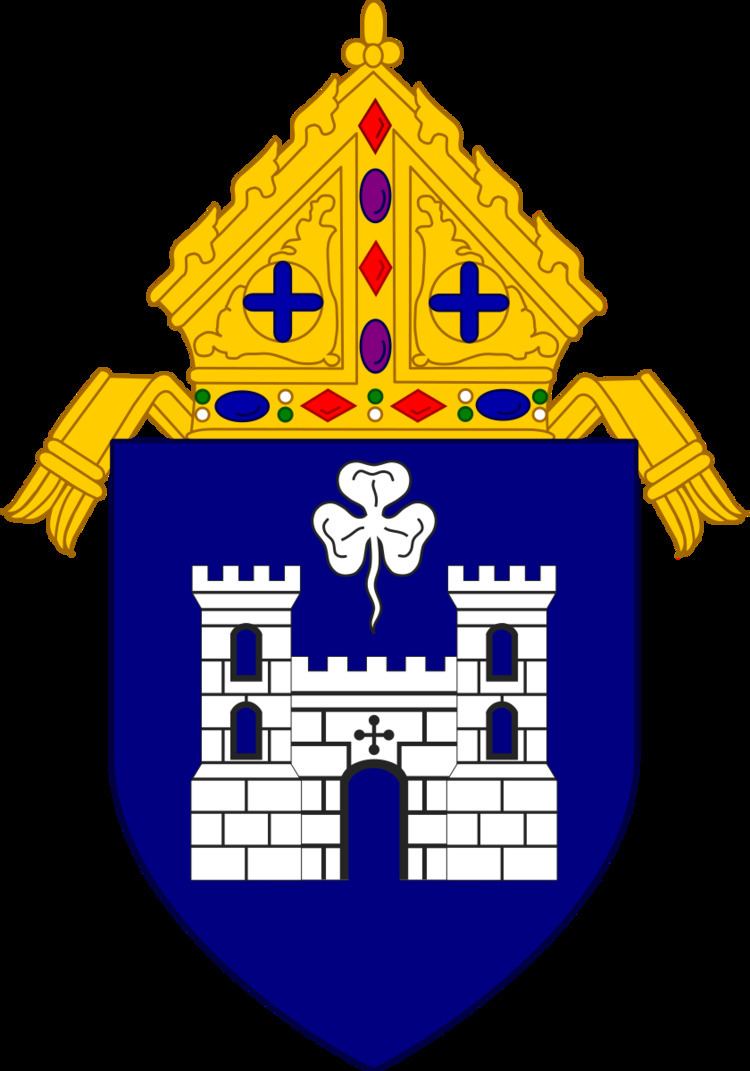Schools 17 Area 62.03 km² Cathedral St. Patrick Cathedral | Parishes 89 | |
 | ||
Population- Total- Catholics 3,260,246710,000 (21.8%) Address 800 W Loop 820 S, Fort Worth, TX 76108, USA Profiles | ||
The Roman Catholic Diocese of Fort Worth in the United States was established on August 9, 1969, after being part of the Diocese of Dallas for 79 years. At present, the diocese has more than 560,000 Catholics in 89 parishes and missions, served by 123 priests, 110 deacons, 24 sisters, and 5 brothers. It is made up of 28 counties of North Central Texas: Archer, Baylor, Bosque, Clay, Comanche, Cooke, Denton, Eastland, Erath, Foard, Hardeman, Hill, Hood, Jack, Johnson, Knox, Montague, Palo Pinto, Parker, Shackelford, Somervell, Stephens, Tarrant, Throckmorton, Wichita, Wilbarger, Wise, and Young with a total of 23,950 mi².
Contents
History
In 1890 the Catholic population of the area of the Brazos and Trinity rivers had grown large enough that Pope Leo XIII established the Diocese of Dallas. As early as 1870 Claude Marie Dubuis, the second bishop of Galveston (which diocese encompassed all of Texas at that time), had begun sending Father Vincent Perrier twice a year to visit Fort Worth. At that time several Catholic families were meeting in the Carrico home. Fort Worth's first parish church was a frame structure built at 1212 Throckmorton Street and called St. Stanislaus Church. It stood until 1907. The cornerstone of St. Patrick's Church, which eventually became St. Patrick Cathedral, was laid in 1888; the church was built just north of St. Stanislaus Church and dedicated in 1892. When Dallas was made a diocese the region that eventually became the Diocese of Fort Worth had seven parishes – Fort Worth, Cleburne, Gainesville, Henrietta, Hillsboro, Muenster, and Weatherford.
The decade of the 1870s witnessed the earliest Catholic education in the area. In 1879 Father Thomas Loughrey, pastor of St. Stanislaus Church, opened a boys' school that operated in the church until 1907. In 1885 the Sisters of Saint Mary of Namur established Saint Ignatius Academy in Fort Worth and Xavier Academy in Denison. In 1910 the same religious institute founded Fort Worth's first Catholic college, Our Lady of Victory College. Other Catholic schools opened in Denton (1874) Weatherford (1880), Muenster (1890 and 1895), Gainesville (1892), Pilot Point (1893), and Cleburne (1896). St. Joseph's Infirmary (now St. Joseph's Hospital) opened in 1885 in Fort Worth.
In 1953 Pope Pius XII changed the name of the Diocese of Dallas to Diocese of Dallas–Fort Worth, and Saint Patrick's Church in Fort Worth was elevated to the status of a co-cathedral. In 1985 St. Patrick Cathedral, St. Ignatius Church, and the St. Ignatius rectory were added to the National Register of Historic Places.
On August 22, 1969, Pope Paul VI separated 28 counties of north central Texas from the Catholic Diocese of Dallas–Fort Worth to form the Diocese of Fort Worth (the remaining territory went back to the "Diocese of Dallas" designation). Two months later, on October 21, Bishop John J. Cassata, a native of Galveston, was installed in St. Patrick Cathedral as Fort Worth's first ordinary. From 1969, when the Diocese of Fort Worth was established, to 1986 the Catholic population increased from 67,000 to 120,000. Meanwhile, in 1981 Bishop Cassata retired, and Pope John Paul II named as his successor a native of Massachusetts who had previously worked in Brownsville, Bishop Joseph P. Delaney.
Under Bishop Delaney the diocese continued to mature. In 1986, it had fourteen primary schools, three secondary schools, the Cassata Learning Center (dedicated in 1975 as an institution offering nontraditional, personalized instruction to the underprivileged of Fort Worth), and a new Catholic Center. The center, a 20,000-square-foot (1,900 m2) edifice, brought together under one roof all of the pastoral and administrative offices of the diocese. Guided by Bishop Delaney, the diocese continued to underscore the principles of the Second Vatican Council, especially a commitment to the poor, to ecumenism, and to an increased role in the church for the laity. In May 2005, Pope Benedict XVI appointed Msgr. Kevin Vann as coadjutor bishop. A coadjutor bishop has right of succession upon the death or retirement of a bishop. On July 12, 2005, Bishop Delaney was found dead at his home, apparently passing away in his sleep. On July 13, 2005, Kevin Vann was ordained bishop as previously scheduled and, because of Bishop Delaney's death, immediately assumed the cathedra of the Diocese.
Bishop Vann was installed as the Bishop of Orange on December 10, 2012.
On November 19, 2013, Pope Francis named Msgr. Michael F. Olson as the fourth bishop of Fort Worth. He was ordained and installed on January 29, 2014.
List of ordinaries
Included are their tenures of service:
- John Joseph Cassata (1969–1980)
- Joseph Patrick Delaney (1981–2005)
- Kevin William Vann (2005–2012)
- Michael Fors Olson (2013–Present)
Associated bishops
Associated bishops refers to men who were priests of the Diocese of Fort Worth before becoming bishops.
